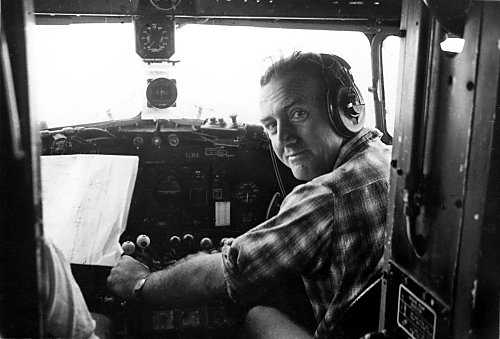|
For reasons
the substance of which I have no recollection now, during 1958-9
Adastra had been negotiating with the RAAF for the purchase of
a surplus Douglas C-47. The transaction had been approved and
on 12 February 1959, Jack Howard and I went with Jack Mc Donald
and (I think) Billy Chambers to Richmond to fly A65-72 to Mascot.
This in itself had involved some negotiating with DCA. Jim Brough
the Chief Examiner at the NSW Region knew that I had flown the
type in the RAAF, but I had to admit I had no recent experience.
Eventually he came to the party and gave me an endorsement on
the basis of my experience and that no passengers would be carried
on a direct flight Richmond – Mascot.
We arrived at Richmond about 1000 hrs and the aircraft was ready
for departure. I cannot remember what work had been done previous
to our arrival, obviously our own engineers must have been to
Richmond and given the aircraft the once over, however it had
not flown for about a year I believe, so such things as hydraulic
operation, undercarriage retraction etc were a bit speculative.
I took Jack Howard up to the cockpit and we went over the drills,
including undercarriage retraction although I intended that we
should do the flight wheels down to avoid the possibility of a
hydraulic failure wheels up which could have been embarrassing
and certainly would have spoilt my standing with Jim Brough!
Anyway we ran the engines and all appeared satisfactory, and as
we closed the door I insisted that the undercarriage locking pins
be removed and carried in the aircraft. Take off was normal and
all went well until at about 500 feet the starboard airscrew ran
away. The aircraft was not doing too well in the wheels down configuration,
with the starboard windmilling at high revs. and low power, so
up came the wheels with a little prayer, and we then tried increasing
power on the starboard and controlling the revs with the feathering
button. I wanted to avoid at all costs generating an incident
in view of the latitude we had been extended, however the feathering
caper was only a very short term solution and as soon as we reached
above 1000 feet we allowed the engine to feather.
Fortunately radar did not notice our abnormally low airspeed and
I made contact with Sydney Tower and requested priority landing
in view of the nature of the flight, stressing that I did not
wish to be faced with having to go around from the approach. Those
were the days when Air Traffic Controllers and pilots could negotiate
on a friendly basis and all was set up for our arrival. At a reasonable
distance out I unfeathered the starboard and we proceeded with
low power and full coarse selected on that side, the aircraft
was light and we had no performance worries. The critical factor
was the undercarriage but at the appropriate time Jack selected
down and the wheels slid into place without protest. All went
as planned and we taxied into the Adastra apron as though nothing
had happened – which of course it hadn’t.
The aircraft was in the hands of the hangar staff for some months
and it was November before it flew again. Our troubles with propellers
were not yet over, however. The aircraft had been fitted with
cropped Mosquito airscrews to improve its high altitude performance
( Alec Bee of De Havilland’s Airscrew section did the practical
work) and Jack Howard and I test flew on 30th November and 1st
December 1959. On the 2nd I began flying with George Treanor,
Airworthiness Surveyor and we did a further 11 hours flying to
check the altitude performance and the propeller characteristics
at altitude. The trouble centred around the propeller hubs, with
the oil congealing in the low temperatures and the propellers
needing frequent exercising to maintain a free flow of oil to
ensure smooth operation and feathering if necessary. At one stage
the Mc Donald touch became evident and a thick felt jacket was
fitted to the propeller domes. Somehow or other it all came together
without the jackets and testing finished on 24th December.
On 29th December I flew VH-AGU to Brisbane with one Len Lymath
as copilot and a survey crew including Bruce Gregory. At Brisbane
I picked up Jack Howard and we flew off to Cairns where we had
survey work to be done on the Barrier Reef. My log book shows
a few flights testing Doppler also but does not mention any significant
success with the equipment.
At Cairns we had one amusing result from operating a DC-3. I had
a ring one Sunday morning from the local manager of Ansett. Their
aircraft with the Sunday papers had gone u/s at Townsville, could
we go and pick up the papers? Cleared it with Sydney and Jack
and I went to Townsville in pretty shonky weather (no questions
asked) and duly delivered the Cairns Sunday papers.
We went to Horn Island on 4th February and worked from there until
23rd March when we went to Cairns and then Brisbane . We had arranged
for Jack to be checked in Brisbane by East-West Airlines and he
was given a Class 1 endorsement which enabled him to operate as
Captain. I left VH-AGU in his capable hands with Bruce Gregory
as his co-pilot.
Reference the initial flight to Mascot, I have to admit that due
to my exceptional record keeping, my log book has a blank page
and no reference to any flying in February 1959. However the details
of the flight are still with me and the date is shown in the aircraft
history. I should add that Jack Mac and Bill did not accompany
us on the delivery flight.
Ted McKenzie
4th April 2003
|
![]()
